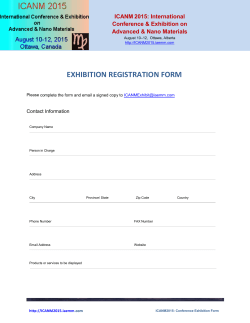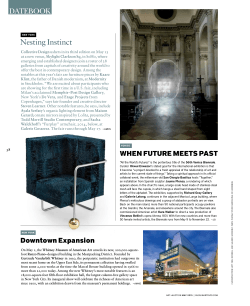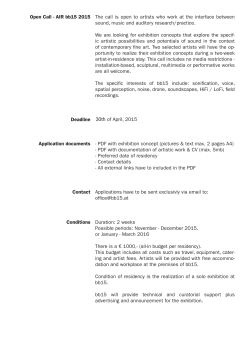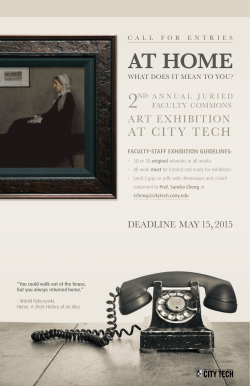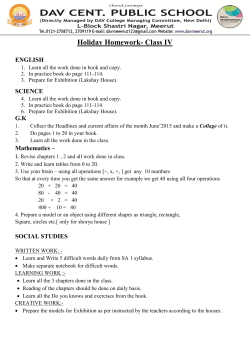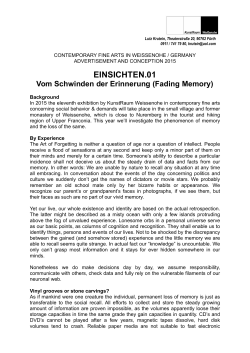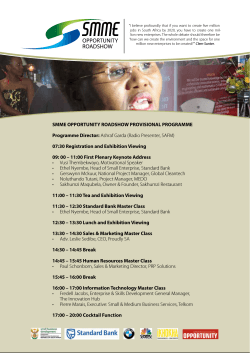
0.2 PAPERS - WordPress.com
AAE 2014 CONFERENCE PROCEEDINGS READING GROUPS 0.2 PAPERS Night at the Museum: Battle for the Future of Architecture Mia Papaefthimiou Universität für angewandte Kunst - Architekten am Graben, Vienna proliferation of architecture in the press begins to 4 elevate its cultural capital . Introduction In the context of the current 2014 Architecture Venice Biennale, entitled Fundamentals, the paper critiques the way architectural culture and practice is represented and framed through the curatorial approach of grand international exhibitions such as the Biennales. During a global period of fragility – economic, social, cultural and political - it is crucial for the future of architecture to rethink the prevailing curatorial perceptions and ethics. The title of the paper, based on the 1993 children’s book by Milan 1 Trenc and then movie trilogy Night at the Museum, where all the exhibits come to life at night, is a playful metaphorical manifestation of the above argument. Architectural exhibitions have the potential to act as a great medium for dialogue, communities’ engagement and participation, social awareness, as well as laboratories for promoting new architectural practices and so much more. Therefore, the paper, by acknowledging exhibitions’ power in the production and presentation of architectural culture to wider society, emphases the need for live, engaging and critical curatorial practices away from categorisations, visual and aesthetic traditions. The paper acts as a platform for dialogue about the future of architecture and its curating as praxis of social change. Interestingly enough, twenty-five years after the Deconstructivist Architecture exhibition, and during the panel discussion of MOMA’s anniversary event, Mark Wigley posed a worthy of note question with an even more noteworthy answer by Tschumi: "Could an exhibition similar to Deconstructivist Architecture happen today? Does today's architectural climate invite a genre-defining moment?” Tschumi replied that there is nothing today to battle for, like postmodern architecture twenty-five years ago, but then he offered that an exhibition today would be called Iconism, addressing the obsessions of architects 5 to make icons . One of the seven architects presented at the 1988 exhibition was Rem Koolhaas; director and curator of the 2014 Architecture Venice Biennale. Fundamentals consists of two main interlocking exhibitions; Absorbing Modernity 1914 – 2014 and Elements which together aim for a modernisation of the core of architecture and 6 architectural thinking . Absorbing Modernity is an invitation to 66 national pavilions to show the process of elimination of national characteristics in favour of a universal adoption of a single language - modernity, while Elements pays close attention to fifteen fundamental elements of a building as chosen by Koolhaas. Elements include: the floor, the wall, the ceiling, the roof, the door, the window, the façade, the balcony, the corridor, the fireplace, the toilet, the stair, 7 the escalator, the elevator and the ramp . ‘Fundamentals will look at histories, try to reconstruct how architecture finds itself in its current situation, and 8 speculate on the future’, said Koolhaas . The curator also argued that the Architecture Biennale was becoming very similar to the art Biennale causing a kind of blur. Therefore, this year’s exhibition will move away from ‘presenting objects and presenting architects’ and will instead show the original research Koolhaas and his 9 team carried out over the last year . The above statement together with his curatorial programme for the exhibition provokes thinking on what the Dutch architect and founder of OMA, considers modernised architecture and his views on the future of the discipline. Architectural Exhibitions Architectural exhibitions play a rather important role in the production of architectural culture and the way architecture is (re)presented. Grand international exhibitions mediate the local, national and transnational and most important Biennials, link the local to the global within the field of symbolic struggles 2 for legitimation . According to Till, MoMA’s 1932 Modern Architecture: International Exhibition, and the first Venice Biennale of Architecture, The Presence of the Past in 1980, were key canonical exhibitions so closely linked with two key architectural movements of the twentieth century - modernism and 3 postmodernism . Despite their short nature, both exhibitions had an impact which extended well beyond their tenure. Another prominent example is the MOMA’s Deconstructivist Architecture exhibition in 1988 which raised the profile of architecture; the curator’s and of course the architects’ exhibited. The exhibition ushered in a media age in which the Attention is paid to the fact that in the selection of the above fifteen elements of architecture, one of the most fundamental elements is excluded, or rather not even 1 AAE 2014 CONFERENCE PROCEEDINGS READING GROUPS 15 considered. In the era of globalisation – arguably what Koolhaas is calling modernity – detaching architecture 10 from its land – or in modern terms, real estate – it only serves to divert society’s attention away from the real political and social issues. In the words of Patrick Schumacher from Zaha Hadid Architects commenting on the Biennale: “architects are in charge of the form 11 of the built environment, not its content” . Following Schumacher’s way of thinking, some would argue that Biennials are just about architecture, excluding anything to do with urbanism, landscape, economic and social crisis. The Biennials of course fit the dominant model of the experience economy, as they are a great tool to market nations and practices 12 internationally . It seems that today they function more like media, rather than a form of critical practice. Architectural exhibitions as a genre have inevitably largely borrowed from the well-established paradigm of Fine Arts displays, which focus on product over process. Duchamp’s disconnected urinal presented in 13 1917 questioned the object of art within an art exhibition. In 2014, an architectural exhibition including a presentation of a series of toilets should offer a deeper critical dimension than just its profane essence. A real toilet, like all the other elements in Koolhaas’ list, is simply an interface connecting a building to sewers and municipal regulations and taxes. With every flush, a toilet re-enacts primary architectural distinctions, which are arguably more fundamental than are the 14 toilet’s elemental characteristics . It is important to note here that this paper has no intention to make a critique on Koolhaas as an architect or/and curator specifically or anyone else in this regard, but rather to open up a discussion about current perceptions and ethics on architecture and its future. disregards as redundant . Moreover, it implies considering the need for architecture to create critical, social and political value suggesting the need for architectural discourse to generate relevant narratives as well as the ability and the will to expand the field outside itself. Therefore, when one talks about curating architecture, one should think about the mediations of a changing profession. During the heights of the modernist period, academia and media contributed to establishing a definition of a successful cultural practice that needed no questioning - some would argue that the current international star-system is the end product of this process. However, this paper argues that nowadays, under the constant shift of economic and cultural consumption, architects have to rethink their values and contributions to the profession and society. As an immediate consequence, in an image-dominated world where critical discourse fails to influence the public, the role of an architectural curator needs to be clarified in some of its values and ambitions. Going back to the question posed by Wigley at the Deconstructivist Architecture panel discussion, it seems that the battle for today’s architects - and arguably curators - will be against what Tschumi and his fellow protagonists have accomplished in the last few decades. With many of the today's iconic buildings designed by architects from that exhibition – including Koolhaas and Hadid – it seems that the panel has ironically provided its own end at the anniversary of their exhibition, calling for new architectural and curatorial practices to step up with alternatives promoting live culture instead of cultural objects. The 2013 Lisbon Architecture Triennale, entitled Close, Closer, supports the paper’s argument from a perspective different to that of the 2014 Venice Architecture Biennale. Lisbon’s Praça da Figueira, a historic centre of the city and the main site of the exhibition, was one year ago the location of massive protests against austerity-focused economic policies. Against the backdrop of economic hardship, the exhibition consisted of a series of workshops, performances and other public events, making it seem more like a work in progress instead of a final product. The diverse programming took more from a strain of socially engaged art practice than the large, Venicestyle installations. The work aimed to draw visitors into discussions about the political and social potential of design, asking how architecture and architectural 16 thinking can be used towards ends beyond building . This curatorial approach reflected the realities and context of a country with one of the highest ratios of architects per inhabitants in the world and 40% of 17 graduate architects being unable to find work . Beatrice Galilee, chef curator of the Triennale commented that the aim of the curating team was to present architecture as not just an object to be 18 mediated, but as the act of mediation itself . Lisbon A curator has a social and cultural responsibility to present an exhibition as a critical device which helps reorganise and restructure the meaning and general perception of architecture and its practice. In this sense, making an exhibition is critical research and a learning process. On the contrary, thinking of an architectural exhibition as only a promotion of a certain practice, a certain author or a certain tendency, like the Deconstructivist Architecture exhibition, becomes an insult to a culturally demanding society. Architecture and everyone involved in practicing, educating, presenting, curating and/or writing about architecture, is accountable to promote and deliver cultural production; accountable as an ethics of praxis. Battle for the Future of Architecture In order to start any kind of discussion about curatorship, the past, present and future of architectural culture and their in-between relationship, it is important to define the cultural and ethical context of the discussion. There is a significant distinction between the curatorial field in architecture as a cultural production and as a technical service with entertainment value. According to Benjamin’s ‘cultural producer’, curating architecture as cultural production implies considering conditions that the media society 2 AAE 2014 CONFERENCE PROCEEDINGS READING GROUPS The paper acts as an open platform for discussion, exchange and further research for the future of architecture and its curating. Triennale relied on debate, performativity and the gathering of several international agents to boost the contact of agents, authors and the public, trusting in both professional networking and in interpolation for general citizens and public. The multidisciplinary curating team of the 2013 Triennale declared that tectonic, technical, representational and conventional notions of architecture were going to be deliberately avoided, as well as big names. According to Tiago Mota Saraiva, this exhibition was the first Triennale that would not present a Portuguese architect; and that 19 alone was completely revolutionary . Therefore, the shift in the curating approach and ethics in the last Triennale is explicit: the agency shown through the engagement and socially-based programme can itself be seen as architecture today and not just the methods to frame and represent it. Please join the discussion by following the blog Night at the Museum: Battle for the Future of Architecture at: http://curarchitect.wordpress.com References 1 Trenc, M. (1993). Night at the Museum. Woodbury, NY: Barron's Educational Series. ; Levy, S. (Director). (2006). Night at the Museum [Motion Picture]. 2 Marchart, O. (2014). The Globalisation of Art and the "Biennials of Resistance". Retrieved 05 15, 2014, from Cumma Papers #7: http://cummastudies.files.wordpress.com/2013/08/cummapapers-7.pdf 3 Till, J. (2009). 'Please do not touch'. In S. Chaplin, & A. Stara, Curating Architecture and the City (pp. 246 - 248). London: Routledge. 4 Pennec, S. (2013, 10 24). Exhibiting Architecture: A Paradox? Retrieved 07 16, 2014, from Domus: http://www.domusweb.it/en/oped/2013/10/24/exhibiting_architecture_a_paradox_.html 5 Hill, J. (2013, 01 28). Deconstructivist Architecture, 25 Years Later. Retrieved 04 20, 2014, from World-architects: http://www.worldarchitects.com/de/pages/insight/deconstructivistarchitecture-25 6 Fundamentals Biennale architetture 2014. (2014). Retrieved 04 08, 2014, from La Biennale: http://www.labiennale.org/en/architecture/index.html 7 Fundamentals Biennale architetture 2014. (2014). Retrieved 04 08, 2014, from La Biennale: http://www.labiennale.org/en/architecture/index.html 8 Hobson, B. (2014, 06 06). Rem Koolhaas' Elements exhibition in Venice aims to "modernise architectural thinking". Retrieved from Dezeen: http://www.dezeen.com/2014/06/06/remkoolhaas-elements-of-architecture-exhibition-movie-venicebiennale-2014/ 9 Hobson, B. (2014, 06 06). Rem Koolhaas' Elements exhibition in Venice aims to "modernise architectural thinking". Retrieved from Dezeen: http://www.dezeen.com/2014/06/06/remkoolhaas-elements-of-architecture-exhibition-movie-venicebiennale-2014/ 10 Martin, R. (2014, 12 05). Fundamental #13. Retrieved 06 15, 2014, from The Design Observer Group: http://places.designobserver.com/feature/real-estate-andthe-responsibility-of-architects/38450/ 11 Winston, A. (2014, 03 18). "Architecture is not art" says Patrick Schumacher in Venice Architecture Biennale rant. Retrieved 05 14, 2014, from Dezeen: http://www.dezeen.com/2014/03/18/architecture-not-artpatrik-schumacher-venice-architecturebiennale-rant/ 12 Vandeputte, T. (2012, 10). Sites of Experimentation: In Conversation with Joseph Grima. Retrieved 06 07, 2014, from OASE Journal for Architecture: http://www.oasejournal.nl/en/Issues/88/SitesOfExperimentat ion#061 13 Gayford, M. (2008, 02 16). Duchamp's Fountain: The Practical Joke that Launced an Artistic Revolution. Retrieved 06 05, 2014, from The Telegraph: http://www.telegraph.co.uk/culture/art/3671180/DuchampsFountain-The-practical-joke-that-launched-an-artisticrevolution.html Conclusion Curatorship has become a focal point as much in the dissemination of architectural culture as in the production of architecture itself. Curating architecture both as a practice, but also as a field of research, seems to have reached a state of disciplinary legitimacy. However paradoxical it may be, exhibitions in general and specifically Biennials, still act as an important medium through which to introduce social and political 20 strategies . As a public platform for dialogue, it resonates both within the architecture communities 21 and within the broader constituencies of society . As an act of representation, this conventional curating approach neglects what is inherent to architectural practice: the potential for transforming environments into embodiments of architectural thinking and 22 experience . Therefore, it is impossible not to agree with Fundamentals at this year’s Architecture Biennale. The time has certainly come to get back to basics. Why not start with architecture and why not do so by adding historical perspective, learning from the past of architecture and its curating practice? The fundamental condition that exhibitions have in common with architecture is that both deploy space in operative and symbolic ways; exhibitions mediate objects in space. When exhibitions are conceived as sites that extend beyond a purely didactic representation and display of objects, they create the circumstances for a more-than 23 cognitive experience for visiting publics . In this way, the exhibition is both part of the act of signification, and an experience of it, becoming, in the words of Michel de Certeau, a ‘spatial practice’ of the narrative 24 structure in which it takes part . The challenge is curating as a practice which disturbs the ways we see and understand architecture. This position is both informed by interdisciplinary theoretical research and by innovative curatorial practices which underline critical positions and produce active spaces. 3 AAE 2014 CONFERENCE PROCEEDINGS READING GROUPS 14 Martin, R. (2014, 12 05). Fundamental #13. Retrieved 06 15, 2014, from The Design Observer Group: http://places.designobserver.com/feature/real-estate-andthe-responsibility-of-architects/38450/ 15 Benjamin, W. (1998). The Author as Producer. In Understanding Brecht. London: Verso. 16 Hanley, W. (2013, 11 22). Exhibitions Review: Close Encounters at the Lisbon Architecture Triennale. Retrieved 02 2, 2014, from Architectural Record: http://archrecord.construction.com/news/2013/11/131122Exhibition-Review-Close-Encounters-at-the-LisbonArchitecture-Triennale.asp?WT.mc_id=rss_archrecord 17 Moreira, I. (2013). 'Post-something' - actions and voices of a generation under 35: the Lisbon Architecture Triennale 2013. Retrieved 06 12, 2014, from Urbanista: http://www.urbanista.org/issues/local-eyes/features/postsomething-actions-and-voices-of-a-generation-under-35-thelisbon-architecture-triennale-2013 18 Wilson, R. (2013, 09 18). Zoom in or Zoom out? Close, Closer: The Lisbon Architecture Triennale. Retrieved 05 05, 2014, from Uncube: http://www.uncubemagazine.com/blog/10764219 19 Sacchetti, V. (2013, 07 20). We don't always need to build. Retrieved 05 05, 2014, from verasacchetti.net: http://verasacchetti.net/?p=84 20 Pennec, S. (2013, 10 24). Exhibiting Architecture: A Paradox? Retrieved 07 16, 2014, from Domus: http://www.domusweb.it/en/oped/2013/10/24/exhibiting_architecture_a_paradox_.html 21 Pennec, S. (2013, 10 24). Exhibiting Architecture: A Paradox? Retrieved 07 16, 2014, from Domus: http://www.domusweb.it/en/oped/2013/10/24/exhibiting_architecture_a_paradox_.html 22 Carter, J. (2012). Architecture by Design: Exhibiting Architecture Architecturally. Media Tropes eJournal Vol III, No 2, 28-58. 23 Psarra, S., & Grajewski, T. (2000). Architecture, Narrative and Promenade in Benson + Forsyth's Museum of Scotland. Arq 4, no. 2, 123-136. 24 Certeau, M. d. (1984). Spatial Stories. In M. d. Certeau, The Practice of Everyday Life (p. 115). Berkeley: University of California Press. 4
© Copyright 2025
